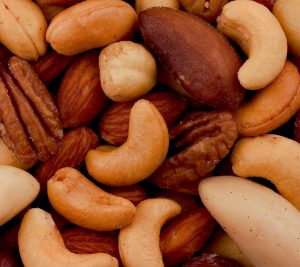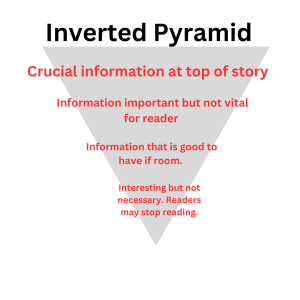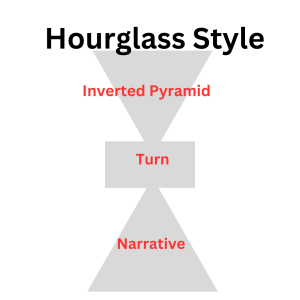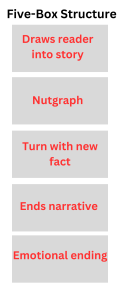10 Chapter 7: Basics of Writing
Top of the News Story
The main goal of this textbook is to teach you how to write a hard news story effectively and accurately. We’ve introduced the tools of ethics, newsworthiness and interviews. Now it’s time to start building a story.
Writing in a news style is difficult because it requires simplicity. You should write clear and simple sentences. Every word is important. Every sentence needs only one idea that tells the reader something new and important. The point of news writing is not to impress the reader with your vast vocabulary, but to provide information succinctly and creatively. If you waste words, you lose readers.
Nut Graf

Perhaps the most important part of any news story is something called the nut paragraph or nut graf. The nut graf is the nut or summary of the story. If the reader sees no other part of the story, the nut graf summarizes the story in general terms.
The Poytner Institute is a nonprofit founded in 1975 that provides journalism training, information and courses. Its website features writing tips, including an article on the nut graf.
Poynter trainer Chip Scanlan writes that the “nut graf tells the reader what the writer is up to; it delivers a promise of the story’s content and message. It’s called the nut graf because, like a nut, it contains the ‘kernel,’ or essential theme, of the story.”
Scanlan outlines the purposes of the nut graf:
- It justifies the story by telling readers why they should care.
- It provides a transition from the lead and explains the lead and its connection to the rest of the story.
- It often tells readers why the story is timely.
- It often includes supporting material that helps readers see why the story is important.
Scanlan also notes a cardinal rule of the nut graf: Shorter is better. A single paragraph of one to two sentences is standard. Occasionally a story calls for more, but that is rare and saved for complicated stories by advanced writers. San Diego Union-Tribune writer David Garrick wrote an excellent nut graf in an Oct. 15, 2023 story about coyotes.
Example:
SAN DIEGO — One woman said her heart nearly stopped recently when she saw a coyote easily jump a 6-foot fence into a neighbor’s Clairemont yard where puppies were playing. Another recently ducked into a side yard in her North Park neighborhood to dodge a coyote walking boldly down Felton Street in broad daylight.
These incidents and many similar confrontations with urban coyotes have convinced people in many San Diego neighborhoods that the wild animals have gotten bolder and that more aggressive intervention is needed by state and local wildlife officials.
Notice that the story isn’t about one person or neighborhood but a countywide trend on coyotes. Another example of a nut graf is by San Diego Union-Tribune writer Kristen Taketa on Oct. 14, 2023.
Example:
Parents at several San Diego Unified schools are raising concerns about a routine district process that they say is increasing class sizes and transferring away valued teachers from their children’s classrooms.
Forced teacher transfers aren’t unique to San Diego Unified, and the district says they’re necessary to align staffing with declining enrollment. But San Diego parents say it tends to happen so late in the school year that it significantly disrupts students’ learning and emotional well-being.
Taketa’s nut graf indicates that this story is about a trend in education.
Body of a News Story
Inverted Pyramid

The body of a news story is different than an English essay. Instead of an introduction, thesis, research and conclusion, news writing gets straight to the point.
The main format used in journalism is called the inverted pyramid. The inverted pyramid format began in 19th-century American journalism, according to an academic paper by Horst Pöttker published in 2005.
In an inverted pyramid, the biggest, most important information is at the top of the story, and the information gets less important – or smaller – as the story proceeds, making it look like an upside-down triangle. Remember that all the information in a story still should be important. A good reporter often leaves more than half of the reported information out of a story. News stories are concise and culled to include only the information that readers need to know. This format helps support that work.
The inverted pyramid came about largely because of the printed press and a lack of space in a physical product, according to another analysis of the style, this one by Negrea Petru-Cristian. Petru-Cristian writes: “In printed press – or any type of paper-based writings – there is the issue of how much one can write on a paper and what to put there. In a sense, there is a limit of what you can do with the text and how to organise everything matters.”
By putting the most important facts first, if a newspaper ran out of space on the physical page, the editor (who was likely on deadline) could simply cut the bottom of the story and send the page to the printer with the knowledge that the best information was still there.
Even without the constraints of the printed page, the form has remained. It makes sense. There may be an infinite amount of space on a website, but readers don’t have an infinite amount of patience. They could stop reading at any time, so this structure makes sure they don’t miss the good stuff.
Narrative Format
I was a feature writer for a decade but struggle to explain narrative writing to journalism students. It feels like a style of writing that should be saved for fiction. Poynter struggled with it as well, as Scanlan points out in a 2003 post titled “What is Narrative, Anyway?”
Scanlan puts on his reporter hat and asks his colleagues, who observe that the storytelling component of fiction can keep news readers engaged.
Wade Rawlins, of the Raleigh News & Observer, tells Scanlan that “narrative is the dirt path that leads us through the impenetrable forest, so we move forward and don’t feel lost.”
Joel Rawson, the executive editor of the Providence Journal, tells Scanlan that narrative writing in journalism uses the following tools:
- Character where a person is revealed or changed
- Scenes described where action occurs
- Time elements including flashbacks
- Technique of descriptive writing and dialogue
- Purpose or theme
After writing about his struggles with narrative in journalism, Scanlan sums up narrative writing well.
“Storytelling journalism employs the techniques of fiction: point of view; time; scene (which includes setting, characters, dialogue); and narrative,” he writes. “Yet it remains true to the tenets of journalism: accuracy; honesty; integrity of intentions.”
Hourglass Style

The inverted pyramid is the main format used in beginning journalism, but it’s worth mentioning others that can be used in news and feature stories.
The hourglass structure was named by Poynter author Roy Peter Clark in 1983 after he noticed that reporters were combining two forms: the inverted pyramid and the narrative, according to Scanlan in a 2003 Poynter article.
The hourglass story is divided into three parts:
- The top includes a summary lead and three or four paragraphs that “answer the reader’s most pressing questions,” Scanlan writes.
- The turn is where the story turns from an inverted pyramid to a chronological narrative. It often includes transitional phrases such as: according to police, witnesses said, students and faculty agree, etc.
- The narrative is the ending that “allows the writer to tell a chronological narrative complete with detail, dialogue and background information,” Scanlan writes.
Five-Box Technique

Poytner’s Scanlan also examined a writing format that helps new writers. Though he wrote about it in 2002, the techniques still work today.
Scanlan wrote that Pulitzer Prize winner Rick Bragg of the New York Times used a five-box technique for his news stories instead of an outline.
- The first box is the lead to draw readers into the story
- The second box is the nut graf or summary of the story
- The third box has new facts that sound like the lead and marks a transition to the narrative part of the story.
- The fourth box finishes the narrative
- The fifth box ends with a quote or image that leaves the reader with a strong emotion.
End of a News Story
People new to news writing are tempted to reiterate the best facts of their story in a summary ending. Resist this temptation to draw a conclusion or add your own thoughts to the story. Remember: This is an objective news story composed of verified facts derived from reporting and research. Even the last paragraph should tell readers something they don’t know. The ending of a news story is often called the kicker.
There are four standard ways to end a news story:
Quote
Your second-best quote is often an effective way to end a story. Your best quote should be the first one in your story. But if there is another great quote that summarizes or complements the story angle, save it for the end. Here is the lead and end of a Oct. 17, 2023 article by Julia Jacobs of the New York Times.
Example:
Lead: Prosecutors will convene a grand jury to consider whether to refile an involuntary manslaughter charge against Alec Baldwin in the fatal shooting of a cinematographer who was killed on the set of the film “Rust” in 2021, New Mexico prosecutors said on Tuesday.
Kicker: “Someone put a live bullet in a gun, a bullet that wasn’t even supposed to be on the property,” Mr. Baldwin said in a television interview just over a month after the tragedy. “Someone is responsible for what happened, and I can’t say who that is, but I know it’s not me.”
Startling Fact
If you have good research or statistics that are not used at the top of a story, consider ending with them. Strengthening the story with more facts is an excellent way to wrap it up, as seen in this Dec. 1, 2023 example from the New York Times.
Example:
Lead: The expulsion of George Santos from Congress on Friday swept away one major political headache for Republicans, but it immediately set the stage for another: The party will have to defend his vulnerable seat in a special election early next year.
Kicker: Mr. Santos himself could theoretically run for the seat as an independent. But the task would be arduous and might jeopardize a more urgent priority: fighting charges that could put him in prison for up to 22 years.
Return to the Top
Consider returning to your lead to wrap up a news story. Some reporters begin with an anecdotal lead and conclude the mini-story at the end of the main story. It helps the reader feel some resolution to the problem introduced in the lead. This type of ending is used in an Oct. 17, 2023 article by Rukmini Callimachi of the New York Times.
Example:
Lead: Chrystal Audet tried to get comfortable in what she called her “bedroom” — the back seat of her eight-year-old Ford Fusion. To stretch her legs, she had to leave a passenger door ajar, but September nights are raw in the Pacific Northwest, with sheets of rain that cut to the bone.
From her own “bedroom” in the front seat, her 26-year-old daughter Cierra Audet asked her to close it.
Kicker: Ms. Audet and her daughter moved in on Sept. 23. For now she is relishing the simplest of human pleasures — the ability to drink as much water as she wants, to take a shower in a space that is fully hers and to stretch out when she sleeps. Her tennis shoes fit again. Yet the math of her life remains precarious. Her sizable debt continues to carve out her salary, leaving too little for rent.
“I’m always, like, on the edge,” said Ms. Audet. “At least I have a car to sit in — and a safe parking lot to be in.”
Future
Telling the reader what’s next is another way to wrap up a story. If a school board voted on new school buses at a meeting, a reporter can end the story by informing the reader when the buses might appear on the street. Consider this example from an Oct. 10, 2023 article by Maxine Joselow of the Washington Post.
Example:
Kicker: At the negotiations in Nairobi, which are scheduled for Oct. 23 through Oct. 27, Hillbrand said he expects officials to begin reevaluating the protocol’s exemption for feedstocks, a topic that made it onto the official agenda.
“It’s a potential next frontier for the protocol,” he said.
News Writing Tips
There are a few common news writing mistakes to consider before you turn in your first news story to your editor or professor.
- Proofread your story at least three times. Yes, it feels daunting. Yes, it is necessary to catch errors.
- Reread your story another time with the sole purpose of trying to remove one unnecessary word from every sentence. Concise writing helps readers.
- Keep yourself out of it. A news story does not need the phrases “I interviewed” or “talked to a reporter.” Keep the story focused on facts and sources. Reporters should be neutral and objective, from outside the story looking in.
- Sentences should be short with one idea each. Cut lengthy sentences in half.
- Paragraphs should be short, no more than one or two sentences.
- Quotes should be their own paragraphs.
- Check the spellings and titles of every source.
- Check quote accuracy.
- Make sure the news story is objective and balanced. The reader should not be able to tell what you think. Nor should they hear from only one side. Instead, provide the reader with all sides of the story and let them decide.
- Outline your story again after you write it. Make sure the story has a discernible outline and transitions so your reader will not feel lost.
- Search for problem words such as “just” and “very” and “unique,” which add subjectivity to an objective story. Delete them.
- Check your attribution. Make sure all but the most obvious facts are paired with attribution.
- Make sure your lead sentence starts with the latest information, not the date, time or attribution.
Key Takeaways
- The nut paragraph, or graf, is the nut or summary of the story. It summarizes the overall story in general terms.
- When writing a news story, the best format is called the inverted pyramid. This calls for putting the most important information at the top and filling in the rest in descending order.
- Other writing formats to consider include:
- narrative writing, with storytelling elements like what you would find in a fiction book.
- the hourglass structure, which combines the inverted pyramid and narrative forms.
- the five-box technique, which helps you outline news stories by filling in boxes before writing.
- Ending a news story is not like the conclusion of an academic essay. Instead of recapping, use a new quote or statistic or revisit the lead. A story also can end on what might happen in the future.
Chapter Exercise
Visit the San Diego mayor’s website and pick a press release. Using the information from the press release, write a news story in the inverted pyramid format. It should be at least 300 words. Note that press releases also are often written using inverted pyramid, but are not objective. Your story should be objective and rewritten. It should have a concise and interesting lead and nut graf. You can use quotes from the press release. Don’t forget to proofread your story.
